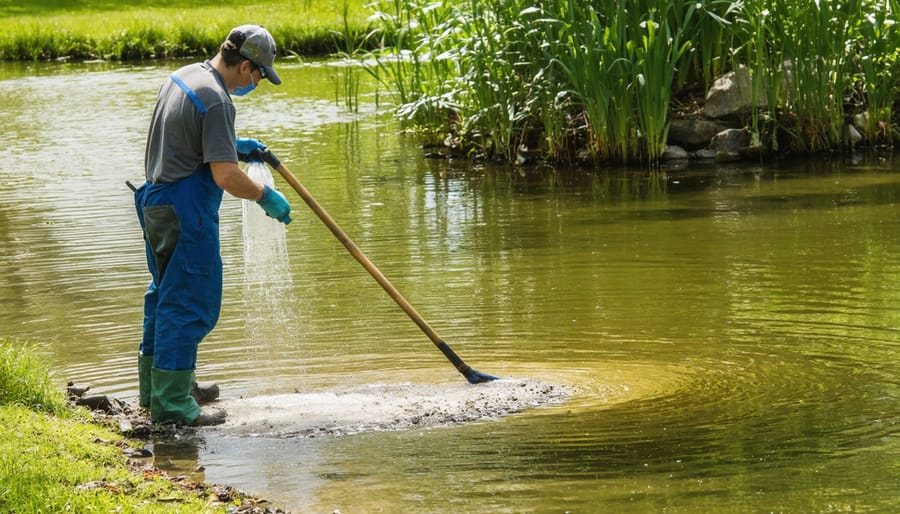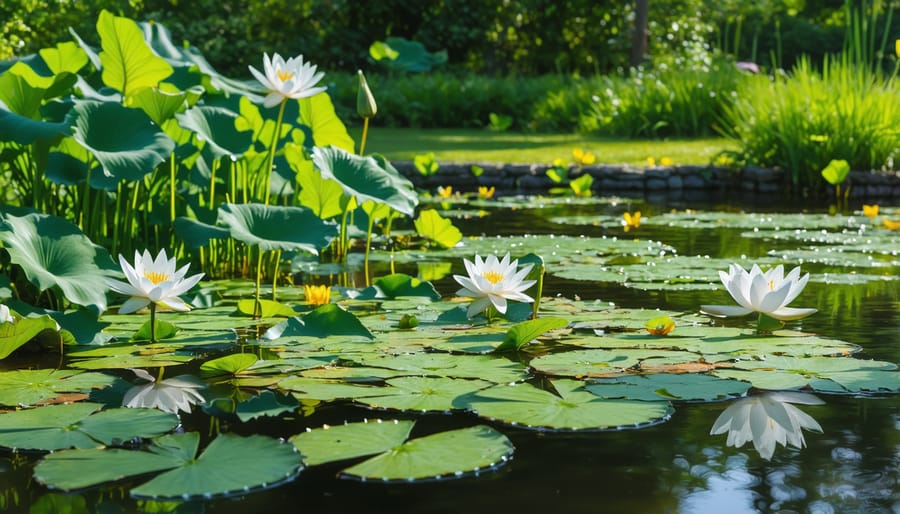
Keep Your Seasonal Fish Pond Thriving Year After Year
Seasonal ponds transform your backyard into a dynamic ecosystem that changes dramatically with each passing season. These natural water features pulse with life, expanding during wet periods and naturally receding during drier months, creating unique habitats that support an incredible variety of wildlife. From spring peepers announcing the thaw to late-summer dragonflies darting across the surface, seasonal ponds offer an ever-changing display of nature’s rhythms.
Unlike permanent water features, these temporary wetlands play a crucial role in supporting specialized species that have adapted to their cyclical nature. Wood frogs, salamanders, and countless invertebrates depend on these ephemeral waters for breeding, while plants like swamp milkweed and cardinal flower thrive in the alternating wet and dry conditions.
Managing a seasonal pond requires understanding its natural cycles and working in harmony with them. Whether you’re maintaining an existing seasonal pond or creating a new one, success lies in embracing the dynamic nature of these water features rather than fighting against it. By following nature’s lead, you can create a thriving ecosystem that provides essential habitat while adding beauty and interest to your property throughout the year.
Spring Awakening: Preparing Your Pond for the Active Season
Spring Cleaning and Water Quality
As winter fades away, it’s time to roll up your sleeves and give your seasonal pond the care it needs. Start by removing any debris that accumulated during the colder months – fallen leaves, twigs, and dead plant material can affect water quality if left unattended. Use a pond net or skimmer to carefully collect this organic matter, being mindful not to disturb any awakening wildlife.
Next, inspect your perfect filtration system and clean or replace filter media as needed. Check pump functionality and ensure all components are working efficiently. This is also the ideal time to examine pond liner integrity and repair any damage you might find.
Water testing is crucial during spring cleaning. Check essential parameters like pH, ammonia, and nitrate levels using a reliable test kit. Aim for a pH between 6.8 and 7.8, and ensure ammonia levels are at zero. If readings are off, make gradual adjustments using appropriate treatments to avoid stressing your pond inhabitants.
Consider adding beneficial bacteria to jump-start the biological filtration process after winter dormancy. These helpful microorganisms break down organic waste and help maintain crystal-clear water. Remember to remove about 15-20% of the old water and replace it with fresh, dechlorinated water to give your pond a healthy start for the growing season.

Reintroducing Fish and Plants
After winter’s rest, reintroducing fish and plants to your seasonal pond requires patience and careful timing. Wait until water temperatures consistently stay above 50°F (10°C) before bringing your fish back home. Begin by floating their transport bags in the pond for 15-20 minutes, allowing them to adjust to the water temperature gradually.
Before releasing your fish, test the water parameters to ensure they’re within safe ranges. Add your fish during the cooler morning hours to minimize stress. Start with a few hardy species first, such as goldfish, and wait a week before introducing more delicate varieties like koi.
For aquatic plants, begin with submerged oxygenators, which help maintain water quality. After a week, add marginal plants around the pond’s edges, followed by floating plants like water lilies. When positioning plants, remember that most aquatic plants prefer full sun, though some marginals can tolerate partial shade.
Don’t rush to feed your fish immediately after reintroduction. Wait 24-48 hours to allow them to acclimate, then start with small amounts of food. Watch for any unusual behavior that might indicate stress. If your fish seem healthy and active after two weeks, you can gradually increase feeding amounts and introduce additional pond inhabitants.
Keep in mind that a newly restarted pond needs time to rebuild its biological balance. Regular monitoring of water quality during the first few weeks will help ensure a successful transition for both plants and fish.
Summer Maintenance: Keeping Your Pond Balanced

Temperature and Oxygen Management
During hot summer months, temperature and oxygen management become crucial for your seasonal pond’s health. As temperatures rise, warm water holds less oxygen, potentially stressing your aquatic life. The key to success lies in maintaining optimal oxygen levels through a combination of smart strategies.
Consider installing a fountain or waterfall if you haven’t already – these features not only add visual appeal but also create essential water movement that increases oxygen absorption. Position them to create gentle ripples across the entire pond surface for maximum benefit.
Shade plays a vital role in temperature control. Adding floating plants like water lilies can provide natural coverage, helping to keep the water cool while offering shelter for fish. Aim to shade about 50-70% of your pond’s surface during peak summer hours.
Monitor water temperature regularly, ideally in the early morning and late afternoon. If you notice temperatures consistently above 75°F (24°C), take action by:
– Running aerators or fountains 24/7
– Adding a backup air pump for emergency situations
– Reducing fish feeding (they need less food in warm water)
– Performing smaller, more frequent water changes with dechlorinated water
Keep an eye on your fish’s behavior – if they’re gasping at the surface or clustering near water returns, it’s a sign that oxygen levels are low and immediate action is needed. Remember, prevention is always better than cure, so implement these measures before problems arise.
Algae Control and Feeding Schedules
Controlling algae in your seasonal pond requires a balanced approach throughout the year. Start by installing a reliable filtration system and maintaining proper water circulation. Adding beneficial bacteria monthly helps break down organic matter that would otherwise feed algae. Floating plants like water lilies and water hyacinths not only add beauty but also provide natural shade, reducing sunlight that algae needs to thrive.
For feeding schedules, remember that fish metabolism changes with the seasons. In spring, as temperatures rise above 50°F (10°C), begin with small amounts of food 2-3 times per week. During summer, feed your fish 2-3 times daily, but only what they can consume within 5 minutes. As autumn approaches, gradually reduce feeding to once daily, and stop completely when temperatures drop below 50°F (10°C).
Natural solutions for algae control include adding barley straw or barley extract to your pond, which releases compounds that inhibit algae growth. UV clarifiers can also effectively control floating algae, while string algae can be manually removed with a pond net or brush.
Remember to test your water parameters weekly during warm months and adjust accordingly. High nutrient levels from overfeeding or decomposing plant matter can trigger algae blooms. Regular water changes of about 10-15% monthly help maintain water quality and prevent excessive algae growth. By following these guidelines and maintaining consistent care routines, you’ll keep your pond clear and your fish healthy throughout the active seasons.
Fall Preparation: Getting Ready for Dormancy
Plant Management and Debris Control
As autumn approaches, falling leaves become a significant challenge for seasonal pond maintenance. Using a pond net stretched above the water can catch leaves before they sink, making cleanup much easier. Remove any fallen leaves from the water surface regularly using a pond skimmer or net, as decomposing plant matter can affect water quality and oxygen levels.
Prepare your aquatic plants for winter by trimming back hardy water lilies and marginal plants to about 2-3 inches above the crown. Remove any dead or yellowing foliage to prevent it from decomposing in the water. Tropical water plants should be brought indoors before the first frost if you want to preserve them for next season.
Consider installing a leaf guard or protective mesh around the pond’s edge to minimize debris entering the water. This barrier also helps protect fish from predators while allowing you to enjoy clear visibility of your pond throughout autumn.
For submerged plants, trim back excess growth to prevent overcrowding and decay during winter months. Leave enough plant mass to provide shelter for any overwintering fish and beneficial microorganisms. Remove any invasive plants completely, including their roots, to prevent spring regrowth.
Create a maintenance schedule to check for and remove debris weekly during fall. This routine will significantly reduce the workload when preparing your pond for winter and ensure a healthier ecosystem come spring.
Fish Care During Temperature Changes
As temperatures fluctuate throughout the seasons, your pond fish require special attention to maintain optimal fish health management. When water temperatures drop, fish metabolism slows down significantly, affecting their feeding patterns and energy needs.
During cooler periods, reduce feeding frequency and switch to a wheat germ-based food that’s easier to digest. Once water temperatures fall below 50°F (10°C), stop feeding altogether, as fish enter a natural period of dormancy. Don’t worry – they’ll survive on their stored fat reserves until spring.
Keep a close eye on your fish’s behavior during temperature transitions. They might appear sluggish or stay near the bottom of the pond – this is perfectly normal. However, if you notice unusual swimming patterns or fish gasping at the surface, check your water quality immediately.
Maintain a section of the pond ice-free during winter using a floating de-icer or aerator. This allows for proper gas exchange and prevents toxic gases from building up under the ice. Avoid breaking the ice by hitting it, as the shock waves can stress or harm your fish.
Remember to remove falling leaves and debris promptly, as decomposing matter can affect water quality and oxygen levels when fish are most vulnerable. These simple adjustments will help ensure your finned friends stay healthy through changing seasons.
Winter Protection: Safeguarding Your Pond
Ice Management and Aeration
During winter months, proper ice management and aeration become crucial for keeping your pond’s ecosystem healthy. When ice forms on the surface, it can trap harmful gases and prevent oxygen exchange, potentially threatening your fish and other aquatic life.
To maintain adequate oxygen levels, install a pond aerator or air pump before the first freeze. Position it about 1-2 feet below the surface, where it can create movement and prevent complete ice coverage. This not only helps oxygenate the water but also keeps a small area free from ice, allowing gases to escape.
Never break ice by hitting it forcefully, as the shock waves can stress or harm your fish. Instead, use a floating de-icer or pond heater to maintain a small ice-free opening. Place it in the deepest part of the pond where fish typically gather during winter. For smaller ponds, a simple floating ball can help prevent complete freezing by moving with the wind.
If you live in an area with heavy snowfall, gently brush excess snow off the ice surface. While a thin layer of snow can actually help insulate the pond, too much blocks vital sunlight that underwater plants need for photosynthesis. Remember, even in winter, these plants contribute to oxygen production.
With these measures in place, your pond will maintain healthy oxygen levels throughout the cold season, ensuring your aquatic ecosystem thrives year-round.

Fish and Equipment Winter Care
When temperatures drop, it’s crucial to protect your fish during winter and safeguard your equipment from freezing damage. For your finned friends, maintain a small ice-free area on the pond’s surface using a floating de-icer or pond heater. This opening allows for proper gas exchange and prevents toxic gases from building up under the ice.
Don’t break ice that forms on the surface, as the shock waves can harm your fish. Instead, place a pot of hot water on the ice to melt a small hole gently. Your fish will naturally settle at the bottom of the pond where the water remains around 39°F (4°C), their ideal winter temperature.
As for equipment, remove and clean your pump, UV clarifier, and filter before the first frost. Store these items in a frost-free location, submerged in clean water to prevent seals from drying out. If you’re keeping your pump running through winter, move it to a shallower depth to help maintain that essential ice-free zone.
Remember to remove fallen leaves and debris before they sink and decompose. A pond net stretched across the surface works wonders for catching leaves before they cause problems. With these simple steps, both your fish and equipment will weather the winter months safely, ready for spring’s return.
Successful pond maintenance is a year-round commitment that rewards you with a thriving aquatic ecosystem. By following seasonal management practices, from spring cleanup to winter preparation, you’ll create a beautiful and healthy water feature that brings joy throughout the year. Remember to monitor water quality regularly, maintain proper filtration, and adjust your care routine as seasons change. Don’t forget to prune plants, manage algae growth, and keep equipment in good working order. With consistent attention and care, your pond will flourish in every season. Make it a habit to check your pond weekly, address issues promptly, and enjoy the peaceful ambiance your well-maintained water garden provides. Your dedication to seasonal maintenance will ensure your pond remains a stunning focal point in your landscape for years to come.
